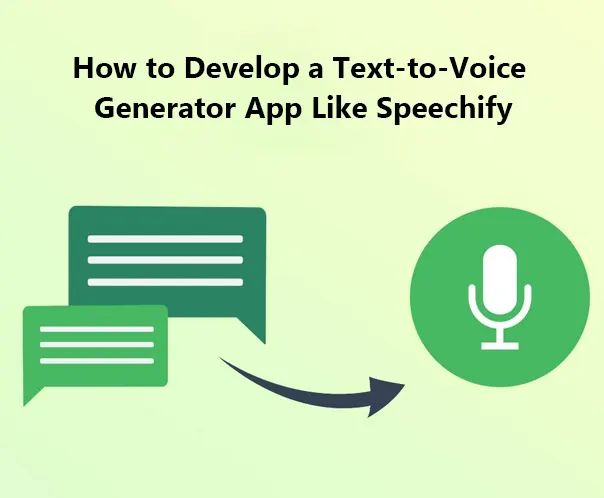This fast-paced world, now dominated by technological innovation, particularly in the sphere of artificial intelligence (AI), continues to shape our lives in extraordinary ways.
One such innovation that is revolutionizing content creation and consumption is the emergence of Text to Voice Generator App.
For aspiring entrepreneurs with a vision for innovation, developing a Text-to-Voice Generator App, similar to the popular Speechify, presents a lucrative opportunity. The Text-to-Voice Generator App market is poised for exponential growth, with projections indicating a potential value of $12.5 billion by 2031.

As such, entrepreneurs must gain a comprehensive understanding of the intricacies, financial considerations, and opportunities inherent in developing a Text to Voice Generator App like Speechify.
Navigating the Transformative Industry Studies of Text-to-Voice Generator Apps!
The Text to Voice Generator App market represents an exciting frontier in AI technology, offering an infinite of possibilities for both creators and consumers of content. By exploiting a transformative journey of AI-driven voice synthesis, these applications can transform written text into natural-sounding speech, catering to diverse user needs across various industries.
From increasing accessibility for individuals with visual impairments to optimizing content consumption for multitasking professionals, the potential applications of Text to Voice Generator Apps are virtually inexhaustible benefits.
Understanding the Business Advantages!
For entrepreneurs considering venturing into the Text to Voice Generator App market, it is essential to recognize the multifaceted advantages that this industry offers. Not only does the growing demand for voice-enabled technologies present ample opportunities for market penetration and growth, but it also fosters innovation in content delivery and accessibility.
Furthermore, the potential for integrating Text to Voice Generator Apps into educational platforms, e-learning modules, and productivity tools underscores the versatility and wide-scale impact of this technology.
Strategic Foresight of Text-to-Voice Generator App!
The journey of developing a Text-to-Voice Generator App necessitates meticulous planning and strategic foresight. From conceptualizing the user interface and voice synthesis algorithms to ensuring seamless integration with diverse content formats, the development process demands a comprehensive understanding of AI, natural language processing, and user experience design.
Moreover, maneuvering the regulatory landscape, intellectual property considerations, and strategic partnerships are integral components of the development journey of the Text-to-Voice Generator App that require careful attention and expertise.
Navigating the Future of Text-to-Voice Generator Apps
As the Text to Voice Generator App market continues to expand in diverse industries, entrepreneurs must remain attuned to emerging trends, user preferences, and technological advancements.
Moreover, fostering a user-centric approach, prioritizing data privacy and security, and embracing continuous innovation is vital for sustaining relevance and competitiveness in this dynamic industry. By staying abreast of market developments and leveraging strategic insights, entrepreneurs can position themselves to capitalize on the transformative potential of Text to Voice generator apps and drive positive change within their respective domains.
Revolutionize Your Reading Experience with Speechify – How?
Speechify, an innovative SaaS provider of AI Voice Generator App, transforms the way we interact with written content. It offers a versatile text-to-speech solution that caters to a multitude of user needs.
Whether you’re a dedicated student looking to maximize study time or a busy professional seeking hands-free email management, Speechify’s diverse suite of offerings can be your go-to solution.
Desktop, Chrome Extension, and Mobile App accessibility!
Speechify offers seamless accessibility across multiple platforms, including desktop, Chrome extension, and mobile apps. Whether you prefer to use your computer, tablet, or smartphone, Speechify ensures that you can access your content anytime, anywhere. This flexibility enables users to integrate Speechify seamlessly into their daily routines, maximizing productivity and convenience.
Sophisticated AI Auditory Learning!
At the core of Speechify’s functionality is its sophisticated AI-driven auditory learning technology. By leveraging the power of artificial intelligence, Speechify transforms written content into natural-sounding speech, enriching the auditory journey of users. With advanced voice synthesis algorithms, Speechify delivers an immersive reading experience, enabling users to absorb information more engagingly and intuitively.
Making written content more accessible!
An essential aspect of Speechify’s mission is to make written content accessible to individuals of all abilities. For those with visual impairments or learning disabilities, Speechify provides a revolutionary tool that breaks down barriers and opens up a world of opportunities. By converting text into spoken words, Speechify enables users to engage with written content effortlessly, fostering inclusivity and promoting equal access to information and educational resources.
Enriches your auditory journey!
Speechify enhances the auditory journey of users, turning reading into an immersive experience. Whether you’re listening to articles, books, or even emails, Speechify’s high-quality voice synthesis technology ensures clarity and a natural cadence, making content consumption a pleasurable and engaging activity. By leveraging the power of auditory learning, Speechify allows users to absorb information faster and retain knowledge more effectively.
Flexibility stretches across various systems!
Speechify’s versatility extends across various scenarios, catering to different user needs. Students can benefit from Speechify’s speed reading feature, enabling them to process large volumes of text efficiently during study sessions. Professionals, on the other hand, can leverage Speechify to manage their emails hands-free, improving productivity and multitasking capabilities. The flexibility of Speechify ensures that users can adapt its use to fit their unique requirements and preferences.
Moreover, Speechify transcends traditional reading methods, providing a transformative text-to-speech solution that enhances accessibility and enriches the auditory journey of users.
Global Text-To-Speech Market: Industry Trends and Forecast!
The global text-to-speech market has witnessed significant growth in recent years and is projected to continue its upward trajectory in the forecast period of 2022-2029.
According to Data Bridge Market Research, the market is expected to reach a value of USD 17.01 billion by 2029, with a compound annual growth rate (CAGR) of 30.20%.
Let’s see what factors drive growth and key components of the text-to-speech industry.
Past Market Size and Growth have been witnessed by AI Voice Generator App!
In 2021, the text-to-speech market was valued at USD 2.06 billion, reflecting the increasing demand for innovative solutions that transform written content into natural-sounding speech. The projected CAGR of 30.20% from 2022 to 2029 underscores the market’s potential for exponential growth. By 2030, the market is estimated to grow steadily at a rate of around 15% from its value of USD 2.45 billion in 2022.
Segmentation by Type, Component, Language, Deployment Mode, Organization, and End-Use!
The global Text to Voice Generator App market can be segmented based on several factors, including type, component, language, deployment mode, organization, and end-use.
The three main types of AI Voice Generator App uses technology include non-neural, neural, and custom solutions.
Software solutions and services comprise the key components of the market.
The language segment encompasses various languages, with English, Spanish, French, Latin, Arabic, Japanese, Chinese, and others being the major contributors.
Deployment modes include cloud-based and on-premise solutions, offering users flexibility in adopting AI Voice Generator ML technology.
Organization sizes, such as small, medium, and large enterprises, can benefit from the wide range of AI Voice Generator App available.
The end-user segment covers industries such as consumer, healthcare, automotive and transportation, finance, education, assistance AI Voice Generator Apps used for visually impaired or disabilities, travel and hospitality, retail, enterprise, and others.
Driving Factors for Growth:
Several factors are driving the growth of the global AI Voice Generator App Like Speechify market. Firstly, the increasing need for accessibility and inclusivity is a key driver. AI Voice Generator technology helps bridge the gap for individuals with visual impairments or learning disabilities, making written content more accessible and enabling equal access to information.
The rising demand for digital content in various industries, including healthcare, education, and automotive, further contributes to market growth.
AI Voice Generator App allows users to consume content hands-free, enhancing productivity and multitasking capabilities. Additionally, advancements in natural language processing, AI, and deep learning algorithms have significantly improved the quality of speech synthesis, boosting the adoption of text-to-AI speech generator solutions.
The global text-to-speech market is experiencing rapid growth, driven by the need for accessibility, digital content consumption, and advancements in AI and natural language processing. With a projected value of USD 17.01 billion by 2029 and a CAGR of 30.20% during the forecast period, the market presents immense opportunities for businesses operating in this sector.
What are the Must-have Features To Build An AI-driven Text-to-Voice Generator App Like Speechify?
AI-driven text-to-voice generator apps have gained immense popularity, enabling users to convert written content into natural-sounding speech effortlessly.
If you are considering developing a similar AI Voice Generator App, it is important to understand the must-have features that will make it successful. In this article, we will explore the essential features necessary to build an AI-driven text-to-voice generator app like Speechify.
Define Your App’s Objectives and Features:
To start, clearly define the objectives and features of your text-to-voice generator app. Consider the target audience and their needs, as this will shape the direction of your app’s development. Whether you are targeting students, professionals, or individuals with visual impairments, understanding user requirements is key to delivering a valuable solution.
Selecting Programming Languages, Frameworks, and Tools:
Choosing the right programming languages, frameworks, and tools is crucial for the development of an AI-driven text-to-voice generator app. Common choices include Python, Java, or C++, and frameworks such as TensorFlow or PyTorch. These technologies provide the foundation for implementing and integrating the necessary machine-learning algorithms and libraries.
Build Voice Customization:
One of the must-have features of a text-to-voice generator app is the ability to customize the voice output. Users should have options to select from a range of voices, including different accents, genders, and age ranges. Incorporating natural language processing techniques can further enhance the voice customization capabilities, allowing users to personalize their reading experience.
Add on Voice Recording and Editing:
To provide users with a comprehensive text-to-voice experience, consider adding voice recording and editing features. This will enable users to record their voices or import audio files and seamlessly integrate them with the generated text-to-voice output. Additionally, offering basic editing functionalities, such as trimming or adjusting audio settings, can enhance user satisfaction.
Audiobook Creation:
An important feature of a text-to-voice generator app is the ability to create audiobooks. This entails converting written content, such as books or articles, into audio files. Implementing a user-friendly interface for importing, managing, and organizing text content, along with the option to save and export audiobooks in various formats, will greatly enhance the app’s functionality.
Collect data by scraping text from the public domain and process!
To train your text-to-voice generator app effectively, you will need to collect data. Scraping text from public domain sources can provide a large dataset for training machine learning models. Additionally, implementing text processing techniques, such as tokenization and language modeling, to preprocess the input text can help enhance the quality and fluency of the generated speech output.
Train Text to Voice Generator App with ML techniques!
The backbone of your text-to-voice generator app lies in its machine-learning models. Using techniques like deep learning and neural networks, train the models to generate high-quality and natural-sounding speech. Utilize libraries such as TensorFlow, Keras, or PyTorch to implement and optimize these models to achieve the desired performance.
Set APIs and libraries to integrate with the Text to Voice Generator App model!
To enable seamless integration with other services, it is important to set up APIs and libraries for your text-to-voice generator app. This will allow other applications or platforms to leverage the capabilities of your app by sending text input and receiving the generated audio output. Providing a well-documented and easy-to-use API will encourage developers to integrate their apps with yours.
Testing and Quality Assurance!
Lastly, thorough testing and quality assurance are vital to ensure a smooth user experience. Test the app under various scenarios, including different languages, text lengths, and voice customization options. Detect and resolve any bugs, inconsistencies, or performance issues to deliver a reliable and user-friendly text-to-voice generator app.
Building an AI-driven text-to-voice generator app requires careful planning and consideration of the must-have features. Defining app objectives, selecting the right technologies, implementing voice customization and editing capabilities, enabling audiobook creation, collecting data, training machine learning models, setting up APIs, and conducting comprehensive testing are essential steps in developing a successful text-to-voice generator app. By incorporating these features, you can create an app that delivers an exceptional and personalized reading experience for users.
Takeaways:
Developing an AI voice generator app like Speechify is a costly undertaking. The cost is influenced by various factors such as platform selection, AI Voice Generator App engine, and post-development maintenance are truly attention-driven and careful consideration of the technology updates required. The cost can vary, but it typically starts at $25,000 or more.
Maven Technology is the best mobile app development agency that specializes in building high-quality AI Voice Generator Apps.
We use the latest AI and ML technologies to create a robust Text to Voice Generator App that emulates successful apps like Speechify. Our development process involves extensive market research and user-focused designs to ensure that we meet user expectations. To ensure long-term success, we provide ongoing updates and support for our apps.
Let us add to your next AI Text-to-Voice Generator App development project to leverage the potential of text-to-speech app technology on your business to enhance accessibility, improve user experiences, and optimize search in various industries, ultimately shaping the future of communication and information access.





